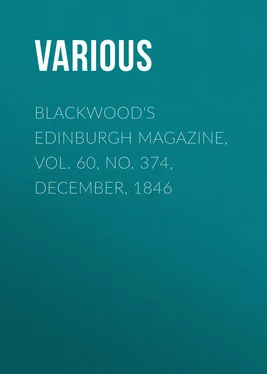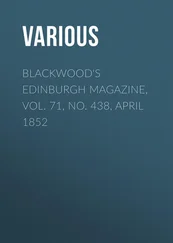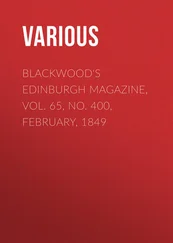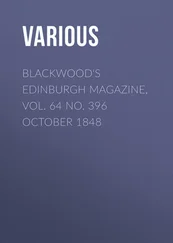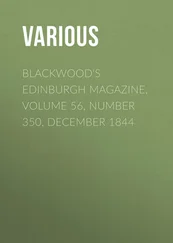Various - Blackwood's Edinburgh Magazine, Vol. 60, No. 374, December, 1846
Здесь есть возможность читать онлайн «Various - Blackwood's Edinburgh Magazine, Vol. 60, No. 374, December, 1846» — ознакомительный отрывок электронной книги совершенно бесплатно, а после прочтения отрывка купить полную версию. В некоторых случаях можно слушать аудио, скачать через торрент в формате fb2 и присутствует краткое содержание. Издательство: Иностранный паблик, Жанр: periodic, foreign_edu, Путешествия и география, на английском языке. Описание произведения, (предисловие) а так же отзывы посетителей доступны на портале библиотеки ЛибКат.
- Название:Blackwood's Edinburgh Magazine, Vol. 60, No. 374, December, 1846
- Автор:
- Издательство:Иностранный паблик
- Жанр:
- Год:неизвестен
- ISBN:нет данных
- Рейтинг книги:4 / 5. Голосов: 1
-
Избранное:Добавить в избранное
- Отзывы:
-
Ваша оценка:
- 80
- 1
- 2
- 3
- 4
- 5
Blackwood's Edinburgh Magazine, Vol. 60, No. 374, December, 1846: краткое содержание, описание и аннотация
Предлагаем к чтению аннотацию, описание, краткое содержание или предисловие (зависит от того, что написал сам автор книги «Blackwood's Edinburgh Magazine, Vol. 60, No. 374, December, 1846»). Если вы не нашли необходимую информацию о книге — напишите в комментариях, мы постараемся отыскать её.
Blackwood's Edinburgh Magazine, Vol. 60, No. 374, December, 1846 — читать онлайн ознакомительный отрывок
Ниже представлен текст книги, разбитый по страницам. Система сохранения места последней прочитанной страницы, позволяет с удобством читать онлайн бесплатно книгу «Blackwood's Edinburgh Magazine, Vol. 60, No. 374, December, 1846», без необходимости каждый раз заново искать на чём Вы остановились. Поставьте закладку, и сможете в любой момент перейти на страницу, на которой закончили чтение.
Интервал:
Закладка:
The customs of the Ditmarschers could not fail to be interesting. That of the Fenstern or Windowing is romantic, and perilous to boot. At dead of night, when all good people are asleep, young gallants cross the marshes and downs for miles to visit the girls of their acquaintance, or it may be the girl of fairest form and most attractions. Arrived at the house, they scale the walls, enter a window, and drop into the chamber of the lady, who lies muffled up to the chin on a bed of down, having taken care to leave a burning lamp on the table, and fire in the stove, that her nocturnal callers may have both light and warmth. Upon the entrance of her visitor, she politely asks him to be seated – his chair being placed at the distance of a few feet from the bed. They converse, and the conversation being brought to an end, the gallant takes his departure either by the door or window. Some opposition has been shown of late to this custom by a few over-scrupulous parents; but the fathers who are bold enough to put bolts on their doors or windows, are certain of meeting with reprisals from the gallants of the district. The Fenstern is subject to certain laws and regulations, by which those who practise it are bound to abide. Another curious custom, and derived like the former from the heathen, was the dance performed at the churching of women up to the close of the last century – the woman herself wearing a green and a red stocking, and hopping upon one leg to church. The Friesic women are small and delicately formed: their skin, beautifully soft and white, is protected most carefully against the rough atmosphere by a mantle, which so completely covers the face, that both in winter and summer little can be seen beyond the eyes of the women encountered in the open streets. The generally sombre hue of the garments renders this muffling the more remarkable; for it is customary for the relatives of those who are at sea to wear mourning until the return of the adventurers. Skirt, boddice, apron, and kerchief, all are dark; and the cloth which so jealously screens the head and face from the sun and storm, is of the same melancholy hue.
The churchyards testify to the fact, that a comparatively small number of those who, year after year, proceed on their perilous expeditions, return to die at home. The monuments almost exclusively record the names of women – a blank being left for that of the absent husband, father, or brother, whose remains are possibly mouldering in another hemisphere. Every device and symbol sculptured in the churchyard has reference to the maritime life, with which they are all so familiar. A ship at anchor, dismasted, with broken tackle, is a favourite image, whilst the inscription quaintly corresponds with the sculptured metaphor. It is usual for the people to erect their monuments during life, and to have the full inscriptions written, leaving room only for the date of the decease. In the island of Fœhr and elsewhere, the custom still prevails of hiring women to make loud lamentations over the body, as it is carried homewards and deposited in the earth. The churches are plain to rudeness, and disfigured with the most barbarous wood carvings of our Saviour, of saints, and popes. These rough buildings are, for the most part, of great antiquity, and traditions tell of their having been brought from England. There can be no doubt that British missionaries were here in former days. At the time of the Reformation, the islanders refused to change their faith; but once converted to Lutheranism, they have remained stanch Protestants ever since, and maintain a becoming veneration for their pastors. The clergy are natives of the islands, and therefore well acquainted with the Friesic dialect, in which they preach. Their pay is necessarily small, and is mostly raised by the voluntary contributions of the parishioners. As may be supposed, the clergy have much influence over the people, especially on the smaller islands, where the inhabitants have but little intercourse with strangers. Temperance societies have been established by the pastors. Brandy, tea, and coffee, came into general use throughout the islands about a century ago, and ardent drinking was in vogue until the interference of the clergy. The Ditmarschers especially, who are allowed to distil without paying excise duties, carried the vice of drunkenness to excess; but they are much improved.
The greatest diversity of languages, or rather of dialects, exists in the islands, arising probably from the fact of Friesic not being a written language. The dialect of the furthest west approaches nearer to English than any other. The people of Amrum are proud of the similarity. They retain the th of the old Icelandic, and have a number of words in which the resemblance of their ancient form of speech to the old Anglo-Saxon English is more apparent than in even the Danish of the present day; as, for instance, Hu mani mile? How many miles? Bradgrum , bridegroom; theenk , think, &c. In many of the words advanced by Mr Kohl, that gentleman evidently betrays an unconsciousness of their being synonymous with the modern Danish; and, therefore, strikingly inimical to his favourite theory of the especial Friesic descent of the English people and language. Little or nothing is known of the actual geographical propagation of the old Friesic. At present it is yielding to the Danish and the Low German in the duchies of Sleswig and Holstein. Many names are still common amongst the people, which seem to have descended from the heathen epoch, and which are, in fact, more frequently heard than the names in the "Roman Calendar," met with elsewhere. Des , Edo , Haje , Pave , Tete , are the names of men; Ehle , Tat , Mantje , Ode , Sieg , are those of women. None of them are known amongst any other people. Much confusion exists with respect to the patronymic, there being no surnames in use in many of the islands. If a man were called Tete , his son Edo would be Edo Tetes ; and then, again, Tat , the wife of the Edo , would be Tat Edos , and his son Des , Des Edos ; whilst Des's son Tete would be Tete Des's , and so on in the most troublesome and perplexing combinations.
The Frieslanders, like other northern nations, are superstitious, and they have a multitude of traditions or sagas, some of them very curious and interesting. We must pass over these instructive myths – always the rarest and most striking portion of a people's history – more cursorily than we could wish, and cite a few only of the most peculiar. The island of Sylt , which is the richest in remains of höogen , the celts of heathen heroes, &c., lays claim to the largest number of Märchen. The most characteristic of all is that of de Mannigfuel , the "colossal ship," (or world,) which was so large that the commander was obliged to ride about the deck in order to give his orders: the sailors that went aloft as boys came down greyheaded, so long a time having elapsed whilst they were rigging the sails. Once, when the ship was in great peril, and the waters were running high, the sailors, disheartened by their protracted watching and labour, threw out ballast in order to lighten the vessel, when, lo! an island arose, and then another, and another still, till land was formed – the earth being, according to the sailors' notion, the secondary formation. Once – many ages afterwards – when the Mannigfuel was endeavouring to pass through the Straits of Dover, the captain ingeniously thought to have the side of the vessel, nearest Dover, rubbed with white soap, and hence the whiteness of the cliffs at Dover. The achievements recounted of de Mannigfuel are endless. The following explanation of the formation of the Straits of Dover is found in a Friesic saga: – Once upon a time, a queen of England, the land to the west of the North Sea, and a king of Denmark, the land to the east of the North Sea, loved each other, and plighted troth; but, as it happened, the king proved faithless, and left the poor queen to wear the willow. England was then joined to the Continent by a chain of hills called Höneden ; and the queen, desiring to wreak vengeance on her false wooer and his subjects, summoned her people around her, and setting them to work for seven years in digging away these hills, at the end of the seventh year the waves pushed furiously through the channel that had been dug, and swept along the coasts of Friesland and Jutland, drowning and carrying away 100,000 persons. To this very hour the Jutland shores yearly tremble before the fatal vengeance of the slighted queen. The Frieslanders are so wedded to this marvellous geological myth, that they insist upon its historical foundation. In some versions 700, in others 7000, in others again, even 700,000 men are said to have been employed in this gigantic undertaking.
Читать дальшеИнтервал:
Закладка:
Похожие книги на «Blackwood's Edinburgh Magazine, Vol. 60, No. 374, December, 1846»
Представляем Вашему вниманию похожие книги на «Blackwood's Edinburgh Magazine, Vol. 60, No. 374, December, 1846» списком для выбора. Мы отобрали схожую по названию и смыслу литературу в надежде предоставить читателям больше вариантов отыскать новые, интересные, ещё непрочитанные произведения.
Обсуждение, отзывы о книге «Blackwood's Edinburgh Magazine, Vol. 60, No. 374, December, 1846» и просто собственные мнения читателей. Оставьте ваши комментарии, напишите, что Вы думаете о произведении, его смысле или главных героях. Укажите что конкретно понравилось, а что нет, и почему Вы так считаете.
